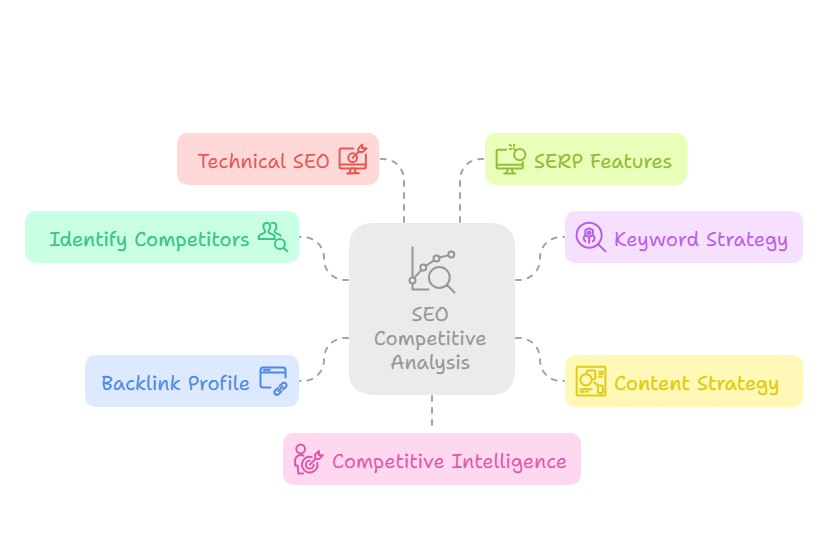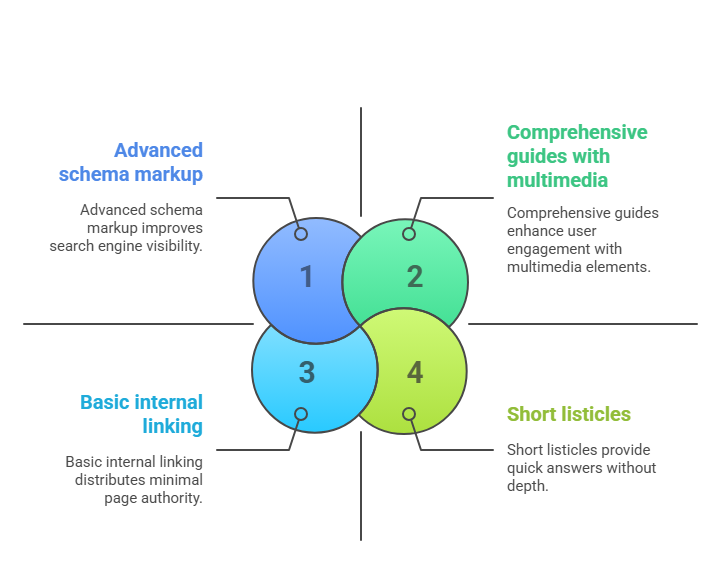Want to beat your competitors in Google? The secret lies in understanding exactly what they’re doing and executing it better.
This comprehensive guide to SEO competitive analysis reveals how to dissect your top competitors’ SEO strategies, identify their winning tactics, and outrank them systematically.
What Is SEO Competitive Analysis?

SEO competitive analysis is the systematic process of identifying your search competitors, analyzing their ranking strategies, and uncovering opportunities to outperform them. Unlike traditional business competitor analysis, SEO competitive analysis focuses specifically on who’s winning in search results for your target keywords.
“The biggest mistake in SEO is trying to reinvent the wheel. Look at what’s already working, then make it 10x better.” – Brian Dean, Backlinko
Your SEO competitors aren’t always your business competitors. A personal blog might outrank Fortune 500 companies for specific keywords simply because they understand search intent better and create more targeted content.
Why Competitive Analysis Is Critical in 2025
The SEO landscape has evolved dramatically. Here’s why competitive analysis has become more crucial than ever:
- AI-driven search algorithms: Google’s RankBrain and BERT updates mean the algorithm understands context and user intent better. Analyzing successful competitors reveals what Google considers high-quality content.
- Increased competition across all niches: Even the most specialized topics now have multiple sites competing for top positions. Understanding the competitive landscape is essential for strategic positioning.
- New ranking factors like E-E-A-T and Core Web Vitals: Experience, Expertise, Authoritativeness, and Trustworthiness signals, combined with technical performance metrics, have changed ranking requirements.
Semrush’s 2024 Ranking Factors Study found that websites implementing competitive SEO insights improved their organic visibility by an average of 127% within six months.
SEO Competitive Analysis

Step 1: Identify Your True SEO Competitors
The foundation of effective competitive analysis lies in identifying the right competitors. Many businesses make the critical error of analyzing only direct business competitors while missing the sites that actually dominate their target keywords.
Consider this scenario: A local bakery might assume their main SEO competitors are other bakeries in town. However, for the keyword “chocolate cake recipe,” their real competitor might be a food blogger from across the country who captures all the search traffic that could lead to cake orders.
Proven Methods for Competitor Identification
- Manual keyword research: Search your top 10 target keywords in incognito mode and document which domains consistently appear in the top 10 results.
- Use SEO tools for domain-level analysis: Tools like Ahrefs’ Competing Domains report or Semrush’s Competitive Research show websites with the highest keyword overlap with your site.
- Analyze SERP features: Note which competitors appear in featured snippets, People Also Ask boxes, and other SERP features for your target keywords.
“Your real SEO competitors are fighting for the same search real estate, not necessarily the same customers.” – Rand Fishkin, SparkToro
Step 2: Decode Their Keyword Strategy
Understanding your competitors’ keyword strategy provides the blueprint for their entire SEO approach. This analysis reveals not just what keywords they target, but how they structure their content strategy around search intent.
Essential Keyword Analysis Components
- Primary keyword targets: Identify their main revenue-driving keywords and content pillars.
- Long-tail keyword opportunities: Discover specific, low-competition phrases they’re capturing that you might be missing.
- Search intent patterns: Analyze whether they focus on informational, navigational, commercial, or transactional keywords.
- Seasonal keyword trends: Identify patterns in their keyword targeting based on industry seasonality.
Recent Ahrefs research shows that long-tail keywords account for 91.8% of all search queries, making competitor long-tail analysis crucial for comprehensive coverage.
Advanced Keyword Analysis Tools and Techniques
- Ahrefs Content Gap Analysis: Reveals keywords your competitors rank for that you don’t target, quantifying missed opportunities.
- Semrush Keyword Gap Tool: Provides detailed keyword overlap analysis and identifies weak spots in your keyword strategy.
- Google Search Console data: Compare your actual search performance against competitor estimated traffic for shared keywords.
Step 3: Dissect Their Content Strategy
Content strategy analysis goes beyond identifying topics. It involves understanding how competitors structure information, what formats they use, and how they optimize for both users and search engines.

“The best content in 2024 doesn’t just answer questions—it anticipates the next question and provides comprehensive solutions.” – Ann Smarty, Search Engine Journal
Comprehensive Content Analysis Framework
- Content depth and comprehensiveness: Analyze word count, topic coverage, and how thoroughly they address search intent.
- Content freshness strategy: Examine how frequently they update existing content and publish new material.
- Content format preferences: Document their use of guides, listicles, case studies, tools, and interactive content.
- Multimedia integration: Assess their use of images, videos, infographics, and interactive elements.
- E-E-A-T optimization: Evaluate author credentials, expert quotes, citations, and trust signals.
Semrush’s Content Marketing Study 2024 found that comprehensive content (3,000+ words) receives 77% more backlinks and ranks higher than shorter content.
Technical Content Optimization Analysis
- Internal linking structure: Map how competitors connect related content and distribute page authority.
- Schema markup implementation: Identify structured data usage that enhances SERP appearance.
- Content optimization patterns: Analyze keyword density, semantic keyword usage, and header tag optimization.
Step 4: Analyze Their Backlink Profile
Backlink analysis reveals how competitors build domain authority and establish topical expertise. This insight is crucial because backlinks remain one of the strongest ranking signals in Google’s algorithm.
Strategic Backlink Analysis Components
- Link acquisition strategies: Identify whether they focus on guest posting, resource page inclusion, broken link building, or digital PR.
- Anchor text distribution: Analyze the ratio of branded, exact match, partial match, and generic anchor texts.
- Link velocity patterns: Understand their link building pace and identify any unnatural spikes or patterns.
- Content that attracts links: Determine which types of content generate the most backlinks in your industry.
“In 2024, it’s not about the quantity of backlinks—it’s about relevance, authority, and the natural acquisition patterns that signal trust to Google.” – Tim Soulo, Ahrefs
Advanced Backlink Intelligence Techniques
- Competitor backlink replication: Identify high-value linking opportunities by analyzing successful competitor link sources.
- Lost link recovery: Find recently lost competitor backlinks that might be available for acquisition.
- Link intersect analysis: Discover websites linking to multiple competitors but not to your site.
Step 5: Evaluate Technical SEO Performance
Technical SEO analysis reveals the foundation that supports competitors’ content and link building efforts. Poor technical implementation can undermine even the best content strategy.
Critical Technical SEO Factors to Analyze
- Core Web Vitals performance: Analyze Largest Contentful Paint (LCP), First Input Delay (FID), and Cumulative Layout Shift (CLS) scores.
- Mobile optimization: Evaluate mobile page speed, responsive design, and mobile user experience.
- Site architecture: Assess URL structure, navigation hierarchy, and internal linking logic.
- Indexability and crawlability: Examine robots.txt, XML sitemaps, and canonical tag implementation.
Google’s Web Vitals Report 2024 indicates that sites meeting Core Web Vitals thresholds see 24% higher search visibility compared to those that don’t.
Technical Analysis Tools
- Google PageSpeed Insights: Provides official Google performance scores and improvement recommendations.
- GTmetrix: Offers detailed performance analysis with waterfall charts and optimization suggestions.
- Screaming Frog SEO Spider: Comprehensive site crawling for technical issue identification.
- Semrush Site Audit: Automated technical SEO analysis with prioritized recommendations.
Step 6: Monitor SERP Features and Visibility
SERP feature analysis reveals opportunities beyond traditional organic rankings. Featured snippets, People Also Ask boxes, and other SERP features can drive significant traffic and visibility.
SERP Feature Optimization Strategies
- Featured snippet analysis: Identify formatting patterns and content structures that win featured snippets in your niche.
- Local pack opportunities: For location-based businesses, analyze local SEO competitive factors.
- Knowledge panel optimization: Understand how competitors establish entity authority for brand-related searches.
- Video and image search presence: Evaluate multimedia content performance in specialized search verticals.
“SERP features are the new ranking positions. Securing position zero through featured snippets often drives more traffic than ranking #1 traditionally.” – Barry Schwartz, Search Engine Roundtable
Step 7: Implement Competitive Intelligence Monitoring
Effective competitive analysis requires ongoing monitoring rather than one-time research. Competitors continuously evolve their strategies, and staying informed about these changes provides ongoing strategic advantages.
Automated Monitoring Setup
- Ranking position tracking: Monitor both your rankings and competitor rankings for shared keywords.
- Content change detection: Use tools like Visualping to track significant website changes.
- Backlink acquisition monitoring: Receive alerts when competitors gain new high-value backlinks.
- SERP feature tracking: Monitor changes in featured snippet ownership and other SERP feature appearances.
Step 8: Develop Your Competitive Advantage Strategy
The ultimate goal of competitive analysis is developing strategies that provide sustainable competitive advantages. This involves identifying gaps in competitor strategies and opportunities for differentiation.
Strategic Implementation Framework
- Content gap exploitation: Create comprehensive content targeting keywords competitors overlook or inadequately address.
- Technical superiority: Ensure your technical SEO implementation exceeds competitor standards.
- Link building differentiation: Develop unique link acquisition strategies competitors haven’t explored.
- User experience optimization: Create superior user experiences that increase engagement metrics and rankings.
Advanced Competitive Analysis Tools Comparison
| Tool | Best Use Case | Unique Strength | Pricing |
|---|---|---|---|
| Ahrefs | Comprehensive backlink analysis | Largest backlink database with 16+ trillion links | $99-$999/month |
| Semrush | All-in-one competitive intelligence | Integrated PPC and SEO competitive analysis | $119-$449/month |
| Moz Pro | User-friendly competitive tracking | Simplified competitive analysis for beginners | $99-$599/month |
| SpyFu | Historical competitive data | 15+ years of ranking and PPC history | $39-$299/month |
Common Competitive Analysis Mistakes to Avoid
Analysis Paralysis
Spending months analyzing competitors without implementing improvements wastes valuable time. Set specific analysis timeframes and force decision-making based on available data.
Copying Without Understanding
Replicating competitor strategies without understanding the underlying principles often leads to poor results. Focus on understanding why strategies work rather than simply copying tactics.
Ignoring Indirect Competitors
Focusing only on direct business competitors misses important SEO insights from sites that rank well for your target keywords but operate in different business models.
Static Analysis Approach
Treating competitive analysis as a one-time project rather than an ongoing process leads to missed opportunities and outdated insights.
Conclusion
SEO competitive analysis provides the strategic intelligence needed to outrank competitors systematically. By understanding what drives competitor success and identifying opportunities they’ve missed, you can develop superior SEO strategies that deliver measurable results.
Start implementing these competitive analysis techniques immediately. Focus on identifying your true SEO competitors, analyzing their successful strategies, and developing superior approaches that provide sustainable competitive advantages.
Remember that competitive analysis is an ongoing process, not a one-time project. Regular monitoring and strategy refinement based on competitive intelligence will keep you ahead of the competition in search results.


